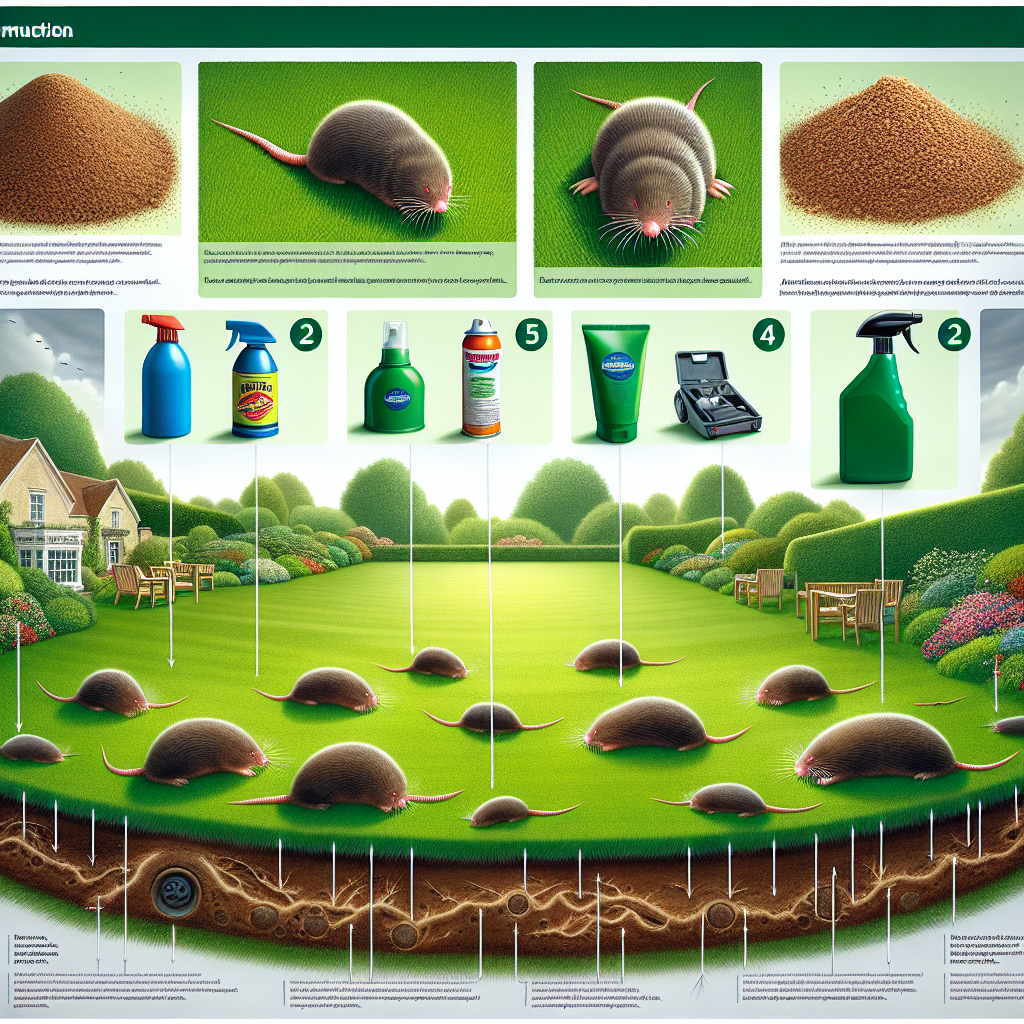How to Stop Moles from Destroying Lawns
Updated April 19, 2024 at 5:57 am
Discover effective strategies to deter moles from wreaking havoc on your pristine lawn, ensuring a smooth, unblemished landscape through tried-and-true methods outlined in our comprehensive guide.

Understanding Mole Behavior and Lawn Damage
Before we dive into combatting moles, it’s vital to understand why moles might be choosing your lawn as their prime real estate. Moles are small mammals that primarily live underground, where they navigate through a network of tunnels. They’re voracious insectivores, feasting on earthworms, grubs, and other soil-dwelling insects. Unfortunately for homeowners, the process of creating these tunnels can cause noticeable damage to lawns, leaving raised ridges and mounds that are unsightly and can be treacherous for walking.
Damage tends to be more extensive during wet seasons or in well-irrigated lawns, attracting the moles to the abundance of prey in the softer soil. If you’re seeing signs of mole activity, such as molehills or spongy-feeling trails beneath the surface of your lawn, it’s time to take action.
Creating an Unwelcoming Environment for Moles
The first step in deterring moles is to make your lawn less appealing to them. This involves targeting their food source – insects. By controlling grub and worm populations, you can reduce the mole’s food supply, making your lawn less attractive. Biological methods, such as introducing beneficial nematodes into your soil, can help reduce grub populations naturally.
Proper lawn upkeep is also crucial. Avoid overwatering your lawn, as moist soil is more attractive to both moles and their prey. Regular mowing, aeration, and thatch removal also promote a healthier lawn that’s less prone to pests.
Natural Repellents to Discourage Moles
For those looking for a humane and environmentally-friendly approach, there are several natural remedies that may discourage moles. One such remedy is using castor oil-based repellents. When applied according to the instructions, these can create an unpleasant environment for the moles, encouraging them to find a new location.
Besides this, planting certain vegetation with a strong scent, like daffodils, marigolds, or alliums, around the perimeter of your yard can act as a natural deterrent. Some even suggest that the smell of coffee grounds sprinkled around tunnels could drive moles away due to its bitter scent.
Physical Barriers and Traps
If non-invasive methods don’t suffice, physical barriers or traps might be your next step. For barriers, burying a wire mesh at least a foot deep and extending a few inches above the ground along the perimeter of your lawn can prevent moles from entering the area.
As for trapping, there are several humane options available. The Victor Out O’Sight Mole Trap is a commonly recommended product with numerous positive reviews. It’s a scissor-type trap that catches moles efficiently without the use of poisons or chemicals. Users often mention its effectiveness even in high activity areas, suggesting it strikes a good balance between user safety and mole capture success.
Find This and More on Amazon
Commercial Mole Repellents and Pesticides
For those with a severe mole problem, commercial repellents and pesticides might be necessary. Look for products with proven results, such as the Sweeney’s Mole and Gopher Granules. Applied as directed, these granules are praised for their ability to discourage moles and are touted for their user-friendly application.
However, remember to use chemical solutions as a last resort, considering their impact on the environment, and always follow the manufacturer’s guidelines to avoid harm to other wildlife or domestic pets.
Professional Mole Control Services
If DIY methods aren’t cutting it, don’t hesitate to call in the professionals. Pest control services can offer more significant expertise and a tailored solution to your mole problem. They are equipped with a variety of methods, from traps to repellents, and can provide a more permanent solution that also considers the overall ecosystem of your garden.
When choosing a pest control service, it’s insightful to look into reviews from other garden enthusiasts. A highly recommended service like Critter Control has testimonials highlighting their humane methods and effective mole removal strategies, which could offer some peace of mind and effectiveness.
Integrating Mole Control with Overall Lawn Care
Maintaining a holistic approach to lawn care is essential when managing moles. Complementing mole control efforts with general lawn health practices, such as proper fertilization and pest-management, leads to a more robust and resilient yard.
Understanding that a healthy lawn starts from the soil up can change your approach. For instance, when you are nurturing indoor plants in low-light conditions, similar to the care tips found in mastering Pothos plant care, the right soil and nutrients can make a significant difference. The same goes for your lawn.
Monitoring and Adjusting Your Approach
Treating a mole issue is not a one-and-done event; it’s an ongoing process. Constantly monitor your lawn for signs of moles, and adjust your control strategies as needed. What works for one season or one yard may not work for another, so flexibility and patience are key.
Remember, maintaining a pristine lawn is akin to fostering ferns in low light: both require attention to detail and a willingness to adapt to changing conditions.
Moles and the Ecosystem: Understanding Their Role
As frustrating as moles can be to homeowners, they do play a vital role in aerating the soil and managing insect populations. By understanding their ecological benefits, you might choose more humane and non-lethal methods of control. Balancing your desire for a beautiful lawn with the health of the local ecosystem is the ultimate act of a responsible gardener.
Just as moles aid in soil health, other garden elements like compost can enrich your soil, similar to the benefits discussed in getting the most from your vegetable garden. It’s about cultivating harmony between all elements of your garden.
Maintaining Vigilance: A Long-Term Strategy
Finally, a successful mole management strategy involves long-term vigilance and diverse approaches. Pairing various deterrents and remedies with continuous monitoring and adjusting techniques can provide lasting results and a healthier lawn.
Just as you might combine multiple care strategies to grow resilient houseplants in challenging conditions, such as thriving with Philodendron Goeldii, a combination of mole control methods can safeguard your lawn’s beauty and health for years to come.
Empathizing with Your Mole Situation
It’s natural to feel frustrated when moles disrupt your laboriously manicured lawn. However, by approaching the situation with empathy for both the creatures and the ecosystem, you can find a solution that respects all parties involved. Effective mole control is not about conquering the issue with brute force; it’s about finding a sustainable balance that works for you and the environment.
By learning from moles and their behaviors, gardeners can develop smart, effective strategies for mole control, just as they learn from the plants they nurture to become better caretakers. Remember, patience, understanding, and adaptability are your best tools in maintaining your garden’s tranquility and aesthetic.
Utilizing Sonic Mole Deterrents
Sonic mole deterrents may sound like a high-tech solution, but they are a non-invasive way to encourage moles to vacate your lawn. These devices emit a vibration or noise under the soil that is supposed to be irritating to moles, potentially driving them away.
Products like the Sweeney’s Sonic Spike have generally positive reviews, with users noting a decrease in visible mole activity. The advantage of such devices is that they can be a humane, poison-free method of mole control. Just be mindful of their effectiveness and be ready to try additional methods if the moles prove stubborn.
Adopting a Two-Pronged Approach: Prevention and Control
While addressing current mole invasions is critical, prevention plays a pivotal role in effective long-term mole management. By creating environmental conditions unfavourable to moles, you can deter new moles from moving in even as you deal with present ones.
Complementing physical interventions with cultural practices, such as maintaining a clean and tidy lawn, will save you time and frustration. Start by cleaning up any piles of leaves or brush where moles could find shelter and concentrate on building a robust lawn that can withstand the occasional mole without significant damage.
When to Call the Professionals
Sometimes, despite your best efforts, moles can be persistent, and that’s when calling a professional might be the prudent choice. These experts can provide comprehensive strategies, which may include advanced trapping methods and specialized deterrents that homeowners might not have access to or feel comfortable using themselves.
Look for reputable companies with experience in humane wildlife management. For those of you who’ve grappled with a stubborn mole issue, turning to professionals can offer a welcome reprieve and return your lawn to its former glory.
Fostering a Healthy Lawn Ecosystem
A flourishing lawn ecosystem is your best defence against moles. Just as you would care for indoor plants, paying attention to soil quality, weed prevention, and appropriate watering, a healthy lawn can withstand nature’s challenges more robustly.
Consider incorporating tactics that improve soil health, like composting. Just like managing compost for your vegetable garden, as discussed in getting the most from your vegetable garden, can elevate your lawn’s resilience and, in turn, make it less inviting to moles.
Debunking Mole Control Myths
As you navigate through the various options for mole control, it’s essential to recognize that not all advice out there is based on evidence. For instance, some people suggest chewing gum or broken glass down mole hills, which has no scientific basis and could be harmful to wildlife.
Focus on methods that have a track record of success. Do your research or consult with professionals if you’re uncertain about the efficacy of a recommended approach. This due diligence can save you time and money in the long run.
Comparing Traditional and Innovative Solutions
While traditional methods like trapping have stood the test of time, innovative solutions continue to emerge. Eco-friendly alternatives, such as biodegradable repellent stakes or soil treatments that enhance natural microbe activity to deter moles, are worth exploring.
Comparing the potential impact, cost, and maintenance requirements of each method will help you design a control plan that aligns with your gardening ethos and practical needs. Remember, a combination of methods may offer the most effective resolution to your mole issues.
Making the Most of Seasonal Mole Behavior
Understanding the seasonal patterns of moles can be key to managing them effectively. Moles tend to be most active during spring and fall when the ground is moist but not frozen, which makes these times ideal for implementing your control strategies.
For example, if you’re applying natural repellents or setting traps, timing these activities to coincide with peak mole activity can increase your chances of success. Patience and timing are critical components when dealing with these subterranean creatures.
Exploring Biological Control Methods
Another angle to consider in your anti-mole arsenal is biological control. The concept of using a biological control agent, such as introducing predators like owls or snakes into the environment, can be an effective long-term solution that works in harmony with nature.
For those who have ample outdoor space, erecting an owl box could attract these natural mole hunters to your garden. While this might not provide immediate results, it’s an eco-conscious approach that benefits the overall biodiversity of your outdoor space.
Choosing the Right Soil Amendments
Soil quality directly affects mole activity; loamy soils full of worms and insects attract moles. If your lawn consists of such soil, consider amending it with sand or other materials that make it less appealing to moles, while still maintaining a healthy environment for grass and plant growth.
Getting the soil composition right is similar to ensuring proper soil mix for your Philodendron Goeldii. It’s about creating a habitat that nourishes the plants you want while deterring the pests you don’t.
Reflecting on the Moral Aspects of Mole Control
Throughout your mole control journey, it’s worth taking a moment to reflect on the methods you choose from an ethical standpoint. While the goal is to protect your lawn, ensuring that the means align with your moral compass will provide you with peace of mind.
Consider the well-being of the moles and the potential impact of your actions on the wider ecosystem. For example, avoiding poisons not only spares non-target wildlife but also keeps your pets and family safe. In mole control, as in all gardening, we tread a line between management and stewardship.
Mole Control as a Community Effort
Lastly, mole control might be more effective when approached as a community effort. Since moles can travel between properties, talking to your neighbors and coordinating control measures can lead to better outcomes for everyone involved.
Shared knowledge and resources, like bulk buying repellents or cooperative hiring of pest control services, can be cost-effective and foster a sense of community. Just as caring for your individual lawn, caring for the neighborhood ecosystem can have far-reaching benefits.
Embracing Eco-Friendly Mole Solutions
Incorporating eco-friendly methods when attempting to stop moles not only protects your lawn but also conserves the local wildlife. Employing practices that do no harm can include using solar-powered sonic repellents, which harness the power of renewable energy to deter moles without the need for batteries or electrical wiring.
Another green approach could involve encouraging the presence of mole predators naturally found in your area. For instance, fostering a habitat for birds of prey can create a natural check on the mole population.
A Balanced Perspective on Mole Control
While it may be challenging to maintain composure when faced with a mole-ravaged lawn, adopting a balanced perspective on mole control can help. Recognizing that moles can contribute to the health of your soil by naturally aerating it and controlling insect populations can lead to a more measured response in addressing the problem.
This can include integrating both short-term remedies and long-term preventative strategies, ensuring that your actions against moles are proportional to the actual damage they cause.
Assessing the Effectiveness of Your Mole Control Measures
It is beneficial to regularly assess the effectiveness of your chosen mole control measures. If you’ve deployed a variety of strategies from trapping to repellents, take note of any changes in mole activity. Are new molehills appearing, or do you notice a decrease in their numbers? Gathering data and reflecting on your actions will guide you towards the most effective course of action.
Such regular assessments can mirror the way you track the progress of indoor plants. Just like the periodic evaluation of a Snake plant’s growth or health, monitoring your lawn for mole activity will inform whether your current strategies are successful or if modifications are necessary.
Investing in Mole-Resistant Lawn Varieties
Investing in mole-resistant grass varieties can be a forward-thinking approach to mitigating mole damage. Some grass types have tougher roots that can endure mole activity better than others, so researching and choosing a hardier lawn variety could save you the hassle of frequent repairs and maintenance.
This proactive measure parallels the choices made when selecting indoor plants for challenging environments. You might choose varieties like the ZZ plant or Cast Iron plant for their robustness in low light, just as you would select a more durable grass type for mole-prone lawns.
Mole Control: A Balance of Patience and Persistence
Effective mole control is a balance of patience and persistence. It might require trial and error to find the perfect combination of strategies that work for your lawn. Be patient as some methods take time to show results, and persistent in experimenting with and tweaking your mole control plan.
Approach mole control like a marathon, not a sprint; much like the long-term care of an indoor Boston Fern, your consistent efforts will yield a thriving, mole-free lawn over time.
Considering Legal and Ethical Constraints
When dealing with moles, it’s important to consider the legal and ethical constraints. Make sure to acquaint yourself with local wildlife laws as mole control measures may be regulated. Also, choosing humane methods reflects not only legal compliance but also a compassionate approach to gardening and pest management.
By acknowledging these constraints, you are showing respect not only for the law but also for the natural world and your neighbors, ensuring your methods are ethically sound and socially responsible.
Conclusion
Ultimately, your journey in controlling moles requires a blend of practical action, ecological awareness, and adaptability. By exploring a spectrum of solutions, from improving lawn health to using various deterrents and repellents, you can approach mole control with a strategy that is not only effective but also mindful of the broader environmental impact.
Remember, the best mole control plan is proactive, considerate, and adaptable to the challenges posed by these industrious little creatures. With time and the right approach, you can regain the beauty of your lawn and live harmoniously with the natural world around you.
Shop more on Amazon
Flowers & Plants Team
Flowers & Plants Team


